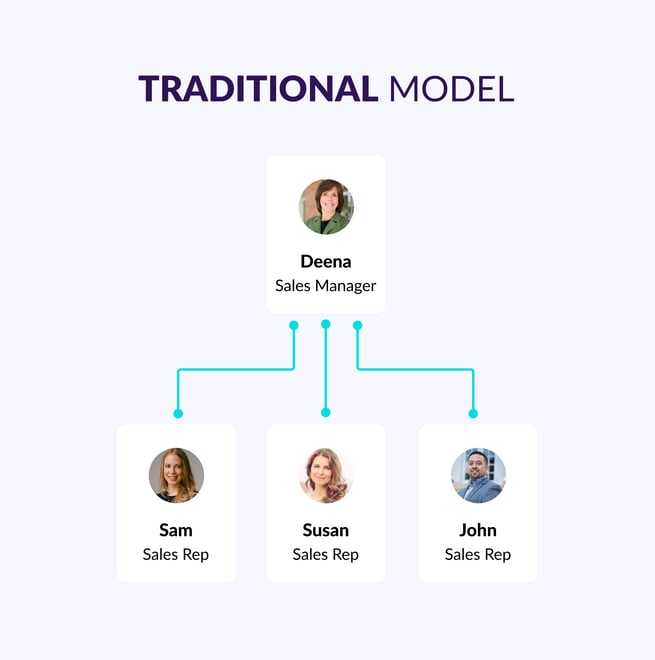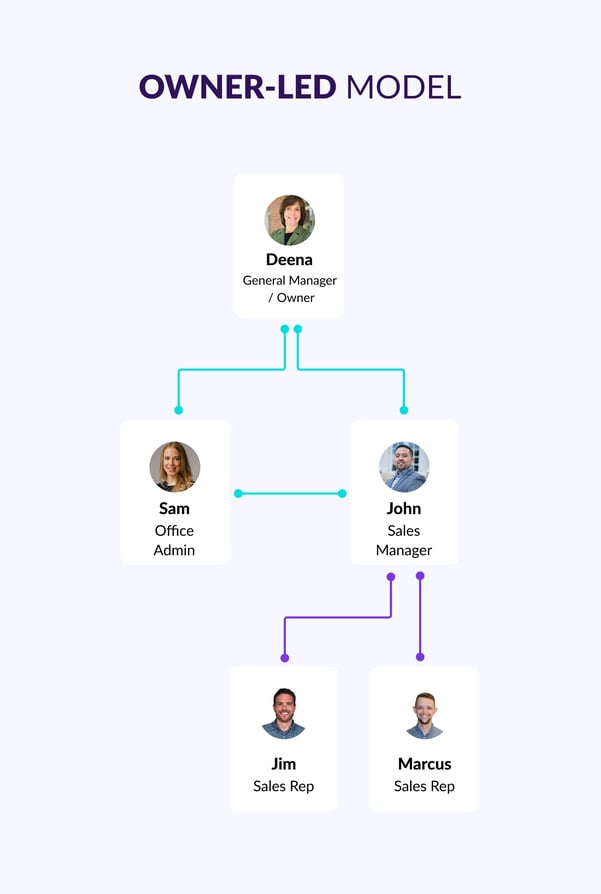What has been most exciting about working at Hatch is watching how it doesn't just benefit home service businesses, but that it is actually transforming them from the inside out—changing way they operate.
One area in particular is the way these companies are structuring their sales teams and processes.
So we wanted to dive in and show you a few different ways to think outside the box when structuring your sales team.
Note that while we incorporate how Hatch shapes and benefits these structures, you don't need to be a Hatch user to implement these methods!
3 sales team models that work
Every company has its own unique sales team and process based on its goals, business model, and even the work style of the sales team members. These three models will help you in shaping yours to get the highest ROI on your tools and team members.
The traditional/sales manager model
We define this model as traditional because its how most sales teams are structured from the get-go.
With this model, the sales manager is the cornerstone and there is typically no one above them in the sales hierarchy. They:
- Monitor incoming leads and ensure that everyone plays by the rules.
- Coach reps to ensure proper product knowledge.
- Provide insights to help lower-performing reps reach their goals.
- Report numbers and metrics to the executive team.
- Pull double-duty on inside and outside sales and are largely responsible for running demos and setting appointments.

How Hatch benefits this structure
- Hatch gives direct insight to conversations, so sales managers can better coach reps and tweak talk tracks or selling points.
- These insights also allow the manager to track accountability, improving the time it takes for reps to reach out to inbound leads and stepping in if there's a recurring issue in a sales process.
- With Hatch mobile, reps aren't tied to a computer inside the office and can respond to inbounds or reply to prospects via text, email, or call in the field.
- Managers can also handle sales conversations if the rep is busy in a meeting or needs assistance with a question.

The owner-led model
As many SMBs are primarily sales-oriented, we've seen this interesting structure pop up, where the entire organization plays some role in sales, from the owner down to the office administrator.
- Although it may not always be an owner, the top of this hierarchy is someone above a sales manager who has insights to the organization's sales efforts.
- The sales manager is free to coordinate and run rehash/re-engagement campaigns.
- What is most interesting about this model is the inside sales rep role that an office administrator takes on using the Hatch platform.
This administrative role:
- Monitors inbound leads
- Schedules appointments,
- Passes information along to reps who are barely in the office, effectively performing the functions of an internal call center.

How Hatch benefits this structure
- With the owner/VP-level insights, the organization can be on the same page from top to bottom.
- Utilizing the office administrator to qualify leads and schedule appointments frees sales reps up to be in the field. With Hatch, they'll receive notifications when the admin has passed them a lead or set an appointment on their calendar.
- The sales manager can then focus in on coaching and hitting numbers and spend less time on monitoring and scheduling appointments for their reps.
- This is also a great way to coach up new sales reps from within. We've seen plenty of admin members become some of the best reps for companies because of the success they have in using Hatch.
The rehash model
We consider this to be perfect end-state sales structure for companies using Hatch.
It is a scenario where a dedicated inside rep owns Hatch. This inside rep:
- Runs and manages rehash campaigns
- Responds to inbound leads within minutes
- Set appointments for reps
- Make sales within the platform
In this scenario, everyone has access to Hatch and uses it for visibility into the entire sales process.

How Hatch benefits this structure
- Outside of a CRM that houses customer data, this model sees Hatch as the sales department's primary tool. Organizations with this structure can often eliminate other overlapping tools and tremendously cut down on internal expenses.
- For organizations that don't have the overhead to fund and staff a call center, this structure is the perfect cost-effective alternative.
Is your sales team structured for success?
Hopefully the sales team models we covered in this post have given you food for thought as to the best way to structure your sales team. The key takeaway is that with processes in place, you can rinse and repeat, and with the right processes governed by the right people, you can ramp up your ROI and raise revenue. And that's a whole lotta R's right there.